Chinese scientists have successfully cloned a rhesus monkey for the first time – but experts say using the same technique to replicate humans is ‘unjustifiable’
It’s been over a quarter of a century since Dolly the sheep became the first cloned mammal.
Now, for the first time, scientists have successfully cloned a rhesus macaque (Macaca mulatta), a primate species known for its close relationship to humans.
The experts in China used somatic cells – animal cells other than sperm and eggs – from a rhesus monkey to make the genetically identical copy.
The clone is ‘healthy’ and has survived for more than two years since its birth in Beijing, unlike previous attempts to clone the species.
However, experts still rule out ‘unwarranted’ human cloning as there are still too many ethical and safety concerns involved.
The healthy rhesus monkey (pictured) survived for more than two years, unlike a previous attempt to clone the species
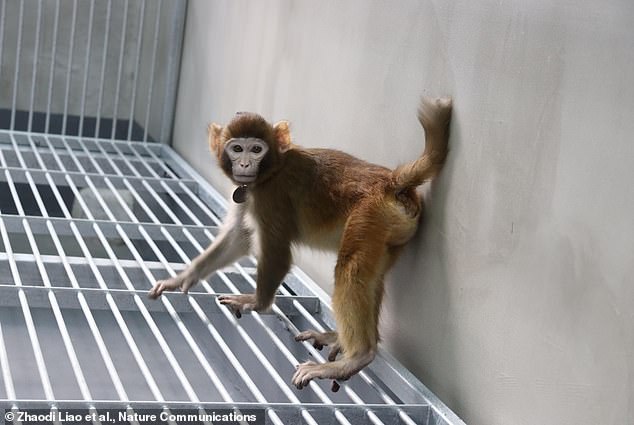
Photograph of the somatic cell cloned rhesus monkey, taken when it was 17 months old. Certain scientists are interested in cloning a range of primates because of their genetic similarities to humans
The The rhesus monkey clone was created using a technique known as somatic cell nuclear transfer (SCNT) by Qiang Sun and colleagues at the University of Chinese Academy of Sciences in Beijing.
The rhesus monkey is interesting because it is anatomically and physiologically close to humans and is already widely used in human health research.
“It is remarkable that so far no rhesus monkey has been cloned via somatic cell nuclear transfer,” the experts say in their article, published today in Nature communication.
‘(We report) the successful cloning of a healthy male rhesus monkey… and introduce a promising strategy for primate cloning.’
The SCNT technique takes a somatic cell, such as a skin cell, and moves its DNA into an egg cell from which the nucleus has been removed.
Somatic cells contain the genetic information about how an organism is built, but cannot produce new organisms. Therefore, the technique involves the transfer of DNA to an egg cell.
If the transfer is successful, the process will lead to a complete reprogramming of the genetic material in the nucleus, allowing the egg to divide and form a cloned embryo, which will be provided with a healthy placenta to grow in.
SCNT has previously resulted in the successful cloning of several mammal species, including Dolly the sheep in 1996.
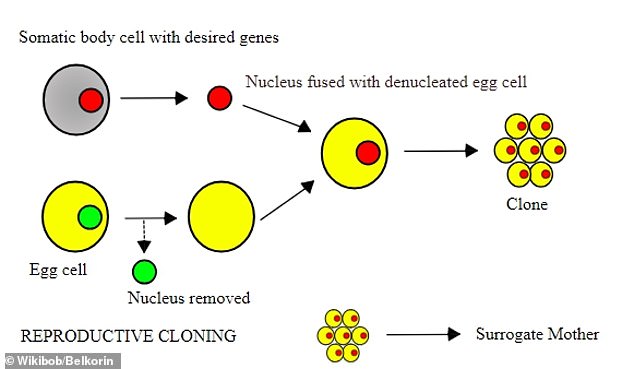
Overview of SCNT: To create somatic cell nuclear transfer (SCNT) clones, scientists take DNA (red circle) from tissue and insert it into eggs (yellow) with the DNA (green) removed. The scientists then turn certain genes on or off to help the cells multiply (right)
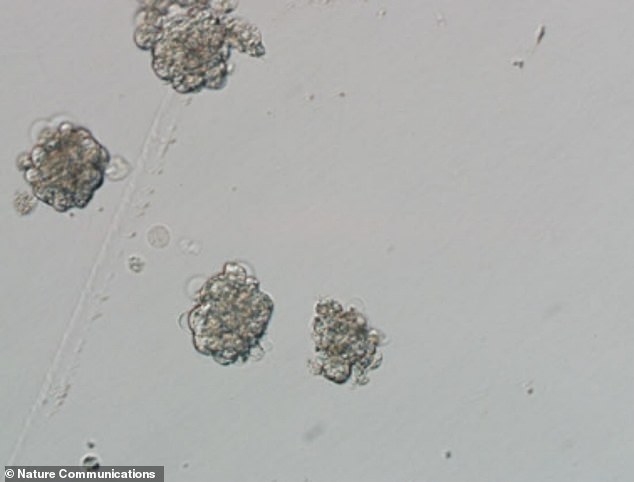
Close-up view of the inner cell mass of the monkey SCNT blastocysts – the clusters of dividing cells made by a fertilized egg
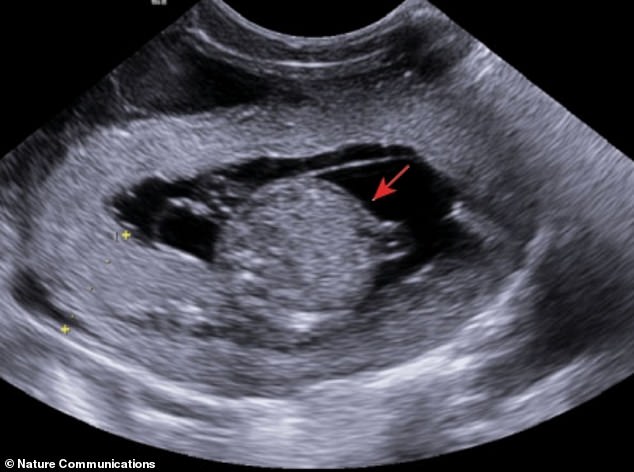
Ultrasound examination of the rhesus fetus on day 60 of gestation (the average gestation period for the species is 165 days)
SCNT was also used in 2017 to create the cloned crab-eating macaques (Macaca fascicularis), named Zhong Zhong and Hua Hua.
The cloning of the two identical female crab-eating macaques was carried out by the same Chinese team, led by Qiang Sun, who has now cloned the rhesus monkey.
However, the cloning efficiency of most mammalian species remains extremely low, with high mortality rates during pregnancy in utero and shortly after birth.
The researchers said that an attempt had previously been made to clone a rhesus monkey by another team in 1997but it was unsuccessful because the creature died 12 hours after birth.
The team was only successful because their efforts resulted in one surviving cloned animal from the 113 initial embryos – a success rate of less than one percent.
According to Dr. Lluís Montoliu, an expert at the National Center for Biotechnology in Spain who was not involved in the new cloning project, it is “extremely difficult to succeed with these experiments.”
“Both the cloning of crab-eating macaques and rhesus monkeys show two things,” he said.
‘Firstly, it is possible to clone primates, and secondly, no less importantly, it is extremely difficult to succeed with these experiments, with such low efficiency, which again rules out human cloning.
‘The authors suggest that this technique should complement the use of both primate species in biomedical research.’
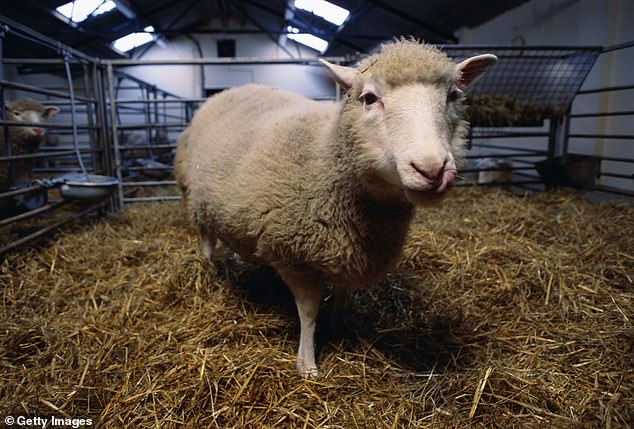
Dolly the sheep (pictured) was born in July 1996 at the Roslin Institute in Edinburgh. It was created from a breast cell of a six-year-old sheep.
Since the birth of Dolly the sheep in 1996, mammals cloned by various teams include cows and mice in 1998, goats in 1999, pigs in 2000, cats and rabbits in 2002, rats and horses in 2003, and dogs in 2005.
But because of their genetic similarity to humans, the broader ambition of certain scientists has been to clone other primates, such as chimpanzees and monkeys.
This could eventually lead to the cloning of people or human body parts, although many experts have raised ethical concerns about this.
Dr. Montoliu said that human cloning is not only “unnecessary and questionable,” but that if attempted it would be “extremely difficult and ethically unjustifiable.”
He said the new experiments could not have been carried out in Europe because of EU law – although cloning animals for scientific research is legal in Britain.
“European Union legislation on animal experimentation prohibits the use of non-human primates unless the experiment is aimed at investigating a serious, life-threatening disease affecting humans or the primate species itself, which is not the case in this experiment,” says Dr. Montoliu. said.
Dr. Robin Lovell-Badge, head of the stem cell biology laboratory at the Francis Crick Institute, said the methods “are still very inefficient and lead to many miscarriages.”
‘The methods do not get us any closer to human reproductive cloning – which has always been a rubbish idea,’ he told MailOnline.
‘It would be unethical purely for security reasons, but why would anyone want to clone someone?
‘The clone may look quite similar to the original person who donates the cells used for the cell nuclear transfer, just as ‘identical twins’ may look very similar (though usually easily distinguished), but they will not have the same character, as we do not be. simply a product of our genes.’
